I got a question about interfacing soft toys from Lauren who made a memory toy from my Calico Signature Bear Pattern that looked like it had been in for dental surgery because the jersey/knit fabric of the baby clothes that she used had stretched so much! Calico Bear is a rather chubby toy but this didn’t sound too good!
Hi Pauline,
I just love your Signature Bear pattern and have made 2 of them with great success. Then I had an epic fail. I used some knit/jersey baby clothes and very thin (the thinnest available) fusible interfacing as a lining. The bear’s face came out all “swollen” like he had his wisdom teeth out. Do you think I just should have used a slightly thicker interfacing?Thanks Lauren
When I designed my Signature Bear Sewing Pattern I used calico (muslin) fabric. This is a woven fabric which has little or no stretch to it. I created the chubby, rounded shape of the bear with the shape of the pattern pieces.
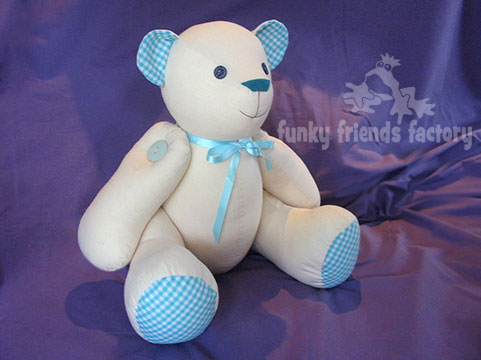
If the pattern is made up using a very stretchy fabric (like the knit/jersey baby clothes fabric) the fabric would stretch more than calico/muslin when you stuff the toy which would make the bear MUCH rounder and larger. So I can imagine what Lauren’s “swollen bear” looked like!
Baby clothes are so cute, it would be a real shame NOT to be able to use them to make soft toys if they are made from a very thin stretchy fabric? I haven’t sewn my toys with fabric like this so I thought I would ask a group of memory toy makers who make gorgeous Funky Friends from baby clothes to find out if they use interfacing when they sew with jersy/knit fabrics.
First to reply was Donna Marie from Made from Memories who makes LOTS and LOTS of Calico Bear Keepsake toys.
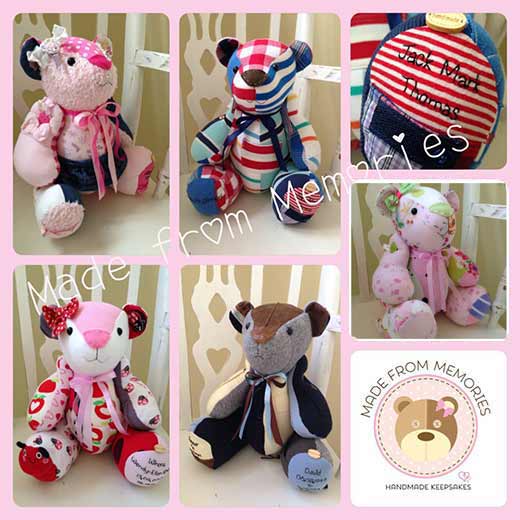 Donna Marie says: I don’t use interfacing at all. I find it far to restrictive and it particularly effects the look of the face. Unless the material is knitted/super stretchy I would recommend not lining and then make sure you don’t over stuff the toy.x
Donna Marie says: I don’t use interfacing at all. I find it far to restrictive and it particularly effects the look of the face. Unless the material is knitted/super stretchy I would recommend not lining and then make sure you don’t over stuff the toy.x
Thanks Donna Marie, this sounds like the way I work with fleece fabric – NO interfacing and don’t stuff too much!
Next to reply was Natalie from Felicitys Friends who makes beautiful handmade keepsake animals from baby’s first clothes.
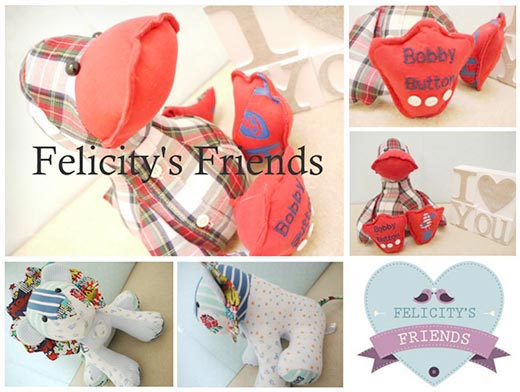 Natalie says: I make Dilby Duck and Larry Lion. I interface everything with woven interfacing and stuff till you can’t stuff no more! If Lauren’s using non-woven (stretchy) interfacing then she needs to make sure that the stretch of the fabric runs in the opposite direction to the stretch of the interfacing. x
Natalie says: I make Dilby Duck and Larry Lion. I interface everything with woven interfacing and stuff till you can’t stuff no more! If Lauren’s using non-woven (stretchy) interfacing then she needs to make sure that the stretch of the fabric runs in the opposite direction to the stretch of the interfacing. x
Thanks Natalie, your tip about placing the stretch of the fabric and interfacing at 90 degrees is so clever! If the stretch of the interfacing runs in the opposite direction to the stretch of the fabric, it will even out the stretch!
Next was Jemma from Oh So Precious Memories who makes beautiful children’s clothes, quilts, bunting and Funky Friends memory toys.
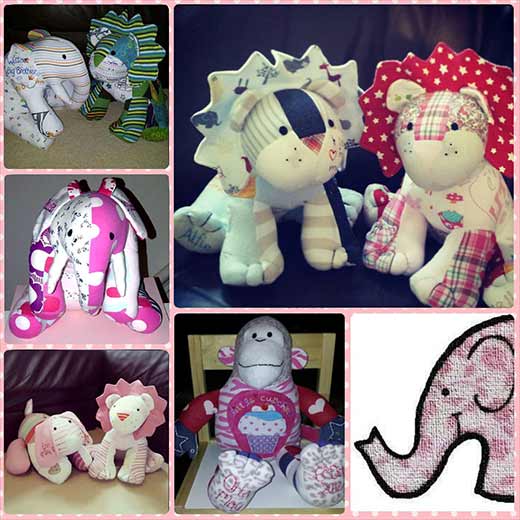
Jemma says: I use medium weight interfacing on my signature bears. I don’t interface Larry Lion, apart from the mane to with thick interfacing to help it stand nicely. I LOVE a lion with a chubby face xx
Thanks Jemma, I love your lion’s chubby faces too! Your tip for interfacing the lion’s mane is great – especially for thin knit/jersey fabrics.
Next was Haley of Making Mini Memories who makes lots of different Funky Friend as memory toys including Ollie Owl, Heather Hippo, Patty the Cow, Dilby Duck, Horsey Horse and Diggles the Dragon!
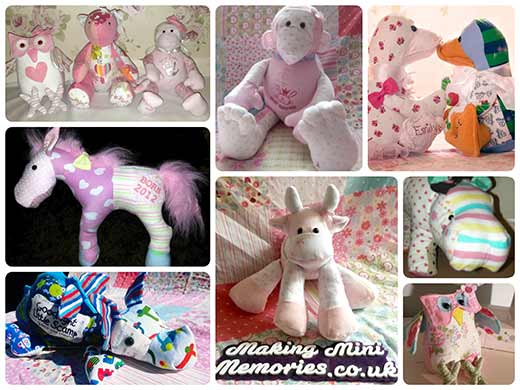
Haley says: I coudn’t live without interfacing and I stuff really tight! 🙂
Thanks Haley, this sounds like me! I stuff and stuff and stuff my toys! I have noticed that the finished toy size is a bit bigger when I have used a stretchy fabric like fleece. If I use a very stretchy knit/jersey fabric I think I will definitely need to interface it first or my toy would turn out enormous and use heaps more stuffing!
Next to reply was Kirsty from Ellie’s Little Wardrobe who makes adorable Funky Friends memory toys as well as quilts from baby clothes.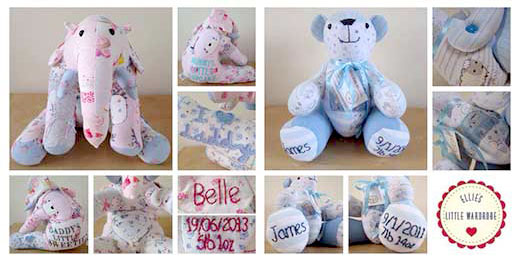 Kirsty says: Hiya. I use lightweight iron on interfacing for Calico Bear I dont interface any other Funky Friends animals though. I also sew Ellie Elephant, Mitch the Monkey, Puppy Dog Pete & Penny Penguin all from baby clothes without interfacing!! Calico needs more support i think with the button joints and i dont like him overstuffed! I think the others all look cute when they are “chubby”. I find it easier to cut the pattern pieces from interfacing, then iron onto the clothes & cut the clothes that way. Rather than drawing onto the clothes. That way they don’t stretch as you trace the pattern.
Kirsty says: Hiya. I use lightweight iron on interfacing for Calico Bear I dont interface any other Funky Friends animals though. I also sew Ellie Elephant, Mitch the Monkey, Puppy Dog Pete & Penny Penguin all from baby clothes without interfacing!! Calico needs more support i think with the button joints and i dont like him overstuffed! I think the others all look cute when they are “chubby”. I find it easier to cut the pattern pieces from interfacing, then iron onto the clothes & cut the clothes that way. Rather than drawing onto the clothes. That way they don’t stretch as you trace the pattern.
Thanks Kirsty, I think your tip to IRON the interfacing onto the fabric FIRST – THEN CUT the pieces out is brilliant!
Next to comment was Danielle from Sew a Gro, who makes beautiful custom blankies and memory toys from babygros including Mitch the Monkey and Puppy Dog Pete.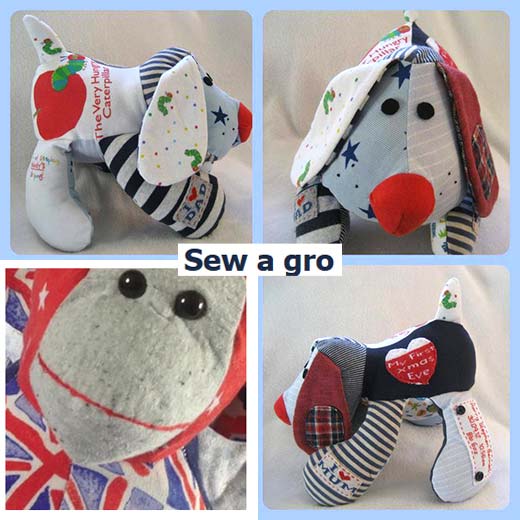 Danielle says: Hello 🙂 I interface all my buddies using a light, yet more expensive, natural, woven, iron-on interface. It stops any stretch yet keeps them feeling soft x
Danielle says: Hello 🙂 I interface all my buddies using a light, yet more expensive, natural, woven, iron-on interface. It stops any stretch yet keeps them feeling soft x
Thanks Danielle, I think your Funky Friends look adorable!
Well, there you have it…
Some people do and some people don’t interface jersy/knit fabric when they make Funky Friends Factory toys from baby clothes… and I think they ALL LOOK GORGEOUS!!!!!
So, it seems there’s no right or wrong way! It’s a personal preference and you need to try different types of interfacing and decided which one works best for you. I think that’s EXACTLY what I am going to do! I’m going to buy some interfacing to experiment with myself! Watch this space! 😀
In the meantime…
I’d love to know if you interface your toys?

. .
Till next time…
Happy Sewing,
Pauline
xxx ![]()



I use a firm iron on interfacing for all my memory toys! They hold their shape much better. I agree with ironing on the interfacing first then drawing round the pattern pieces. Makes life alot easier! I experimented with different interfacing before finding one that worked for me.
I’m fairly new to making funky friends toys .. and I’ve been experimenting with fabrics .. my next experiment was going to be trying interfacing .. I have a tip for drawing round pattern pieces place the fabric onto fine sandpaper then draw round the pieces .. the sandpaper stops the fabric moving and stretching as you draw
I haven’t heard of using sand paper before – sounds interesting! 😀
I don’t but then I’ve only used quilting cottons to make my toys and they react differently
I’m going to try it with the interfacing now, I never thought to try it, thanks.